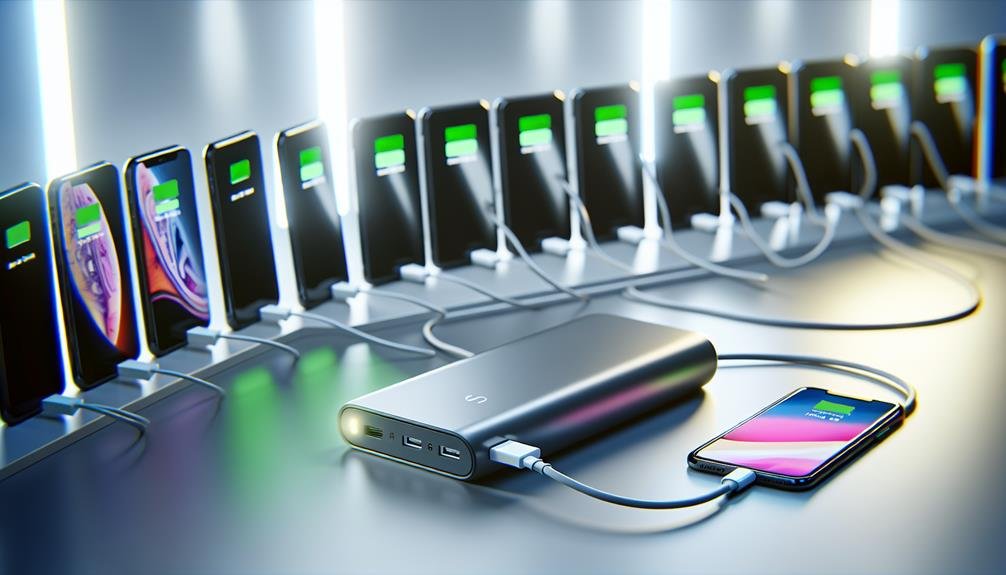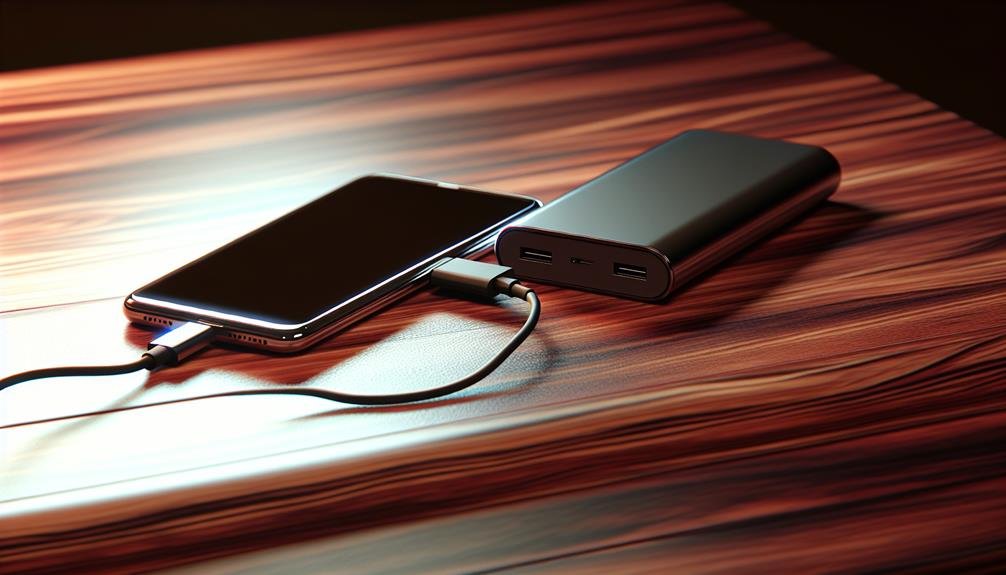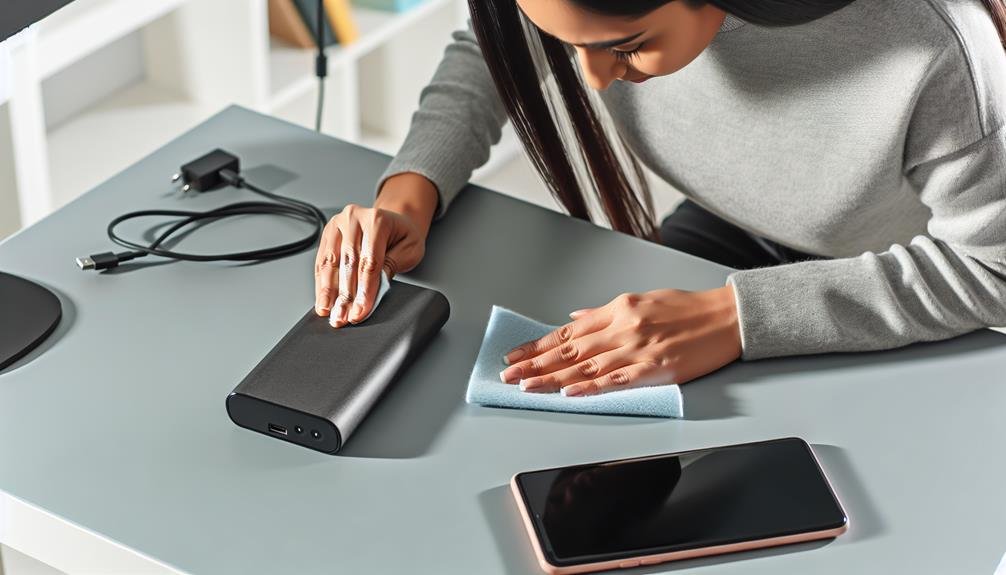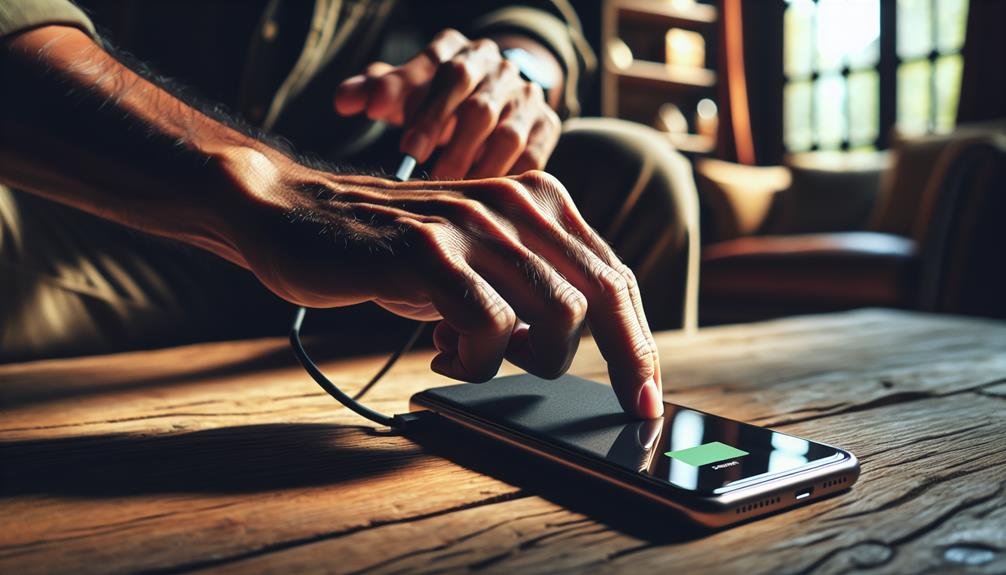To charge your phone with a power bank, first, make sure it's compatible with your phone's specifications and has sufficient mAh capacity. Use the appropriate cable—USB-C, Micro-USB, or Lightning—matching your device's port. Connect the cable to the power bank's output and then to your phone. Check for a charging symbol on your phone and make sure it's charging at the desired speed. Avoid heavy usage and keep the power bank well-ventilated during charging. Monitor the battery levels and connections closely. For efficient charging performance and safety, you'll want to explore further details on power bank maintenance and usage techniques.
Choose the Right Power Bank

When selecting the appropriate power bank, consider its capacity, measured in milliampere-hours (mAh), to meet your phone's charging requirements. It's important to confirm power bank compatibility with your device. Check the specifications of both your phone and the power bank. Look for power banks that support your phone's charging standards to avoid any potential damage or inefficient charging.
Charging speed is another significant factor. Most modern power banks offer fast charging capabilities, but you'll need to verify that your phone can handle the increased amperage. A power bank with multiple output ports can be useful if you plan to charge several devices simultaneously.
Pay attention to the portable design and battery life of the power bank. A compact, lightweight model is ideal for carrying around. However, balance portability with the power bank's capacity to ensure it can fully charge your device at least once, if not multiple times.
For safety, choose power banks with built-in protection features such as overcharge, over-discharge, and short-circuit protection. These features will safeguard your devices and extend the lifespan of the power bank itself.
Check Power Bank Capacity
To ensure your power bank can meet your charging needs, start by checking its capacity, typically measured in milliampere-hours (mAh). This figure indicates how much energy the power bank can store. A higher mAh means more charges for your phone. For example, if your phone's battery is 3000mAh, a 10000mAh power bank can charge it approximately three times.
Ensure power bank compatibility by comparing the output voltage and current (usually marked as 5V/2A) with your phone's charging requirements. Incompatible voltages can harm your device or the power bank, compromising battery health and safety.
Charging speed is another essential factor. Power banks with higher output currents (e.g., 2.4A or 3A) charge devices faster than those with lower currents. Look for features like Quick Charge or Power Delivery for enhanced charging speed.
Evaluate the power bank's efficiency and portability. High-capacity models offer more portable convenience but may be bulkier. Assess your daily needs—if you're often on the go, a balance between capacity and size is vital.
Connect Your Devices

After confirming your power bank's capacity and compatibility, it's time to connect your devices for charging. First, you'll need to select the appropriate cable type for your phone. Most modern phones require either a USB-C, Micro-USB, or Lightning cable. Make sure the cable you're using is in good condition to avoid any potential hazards.
Next, plug the appropriate end of the charging cable into your phone. The other end goes into one of the power bank's output ports. It's essential to check if your power bank supports fast charging, as this can greatly impact charging speed. Some power banks feature multiple output ports with different voltage and current ratings, so make sure you choose the port that matches your phone's charging requirements.
When connecting your devices, pay attention to the compatibility between the power bank and your phone. Using an incompatible setup may not only slow down charging speed but also potentially harm your phone's battery life. Always use manufacturer-recommended cables and avoid mixing different brands if possible.
With everything connected correctly, your phone should start charging immediately. Double-check the connections to make sure they are secure and that there are no loose or exposed wires.
Monitor Charging Process
How do you validate your phone is charging correctly and efficiently once connected to the power bank? First, check your phone's battery level and notifications. Your phone should display a charging symbol, often a lightning bolt, on the battery indicator. Additionally, a notification may appear indicating the charging speed—whether it's fast charging, normal charging, or slow charging.
Keep an eye on the charging speed. A quicker charge might be convenient but can generate more heat. Here are some safety tips: avoid using your phone extensively while charging, as this can cause overheating. Ensure your power bank and phone are placed on a flat, hard surface to allow proper ventilation.
| Aspect | Instructions |
|---|---|
| Battery Level | Check the battery icon and charging symbol. |
| Notifications | Look for charging notifications on your screen. |
| Charging Speed | Verify if it's fast, normal, or slow charging. |
| Safety Tips | Avoid using phone heavily; ensure ventilation. |
Monitoring the charging process isn't just about efficiency; it's also about safety. Overheating can damage both your phone and power bank. If you notice any unusual heat or your phone isn't charging as expected, disconnect immediately and troubleshoot the issue. Always prioritize safe charging practices to prolong the lifespan of your devices.
Maintain Your Power Bank

Maintaining your power bank involves regularly checking its battery health and ensuring its software is up-to-date. Start by monitoring the battery lifespan; most power banks have a limited number of charge cycles. Refer to the manufacturer's guidelines for specifics. To keep the battery in best condition, avoid depleting it completely; instead, recharge it when it drops to around 20-30%.
For storage tips, store your power bank in a cool, dry place. Avoid exposing it to extreme temperatures, as this can degrade the battery. If you don't plan to use your power bank for an extended period, store it with a 50% charge to maintain battery health.
Regular cleaning is essential. Use a soft cloth to wipe down the exterior, and avoid using harsh chemicals that could damage the casing or internal components. Check the ports for dust and debris, using compressed air if needed.
When it comes to troubleshooting, if your power bank isn't holding a charge or is charging devices slowly, it might need a software update. Consult the user manual or manufacturer's website for software update instructions. If issues persist, contact customer support for further assistance.
Frequently Asked Questions
Can a Power Bank Charge Other Devices Besides Phones?
Yes, you can. Power bank compatibility isn't limited to just phones. They're designed for charging multiple devices like tablets, cameras, and smartwatches. Always check the voltage and safety guidelines to guarantee proper and safe usage.
How Long Does a Power Bank Usually Take to Charge Fully?
Did you know some power banks can charge fully in just 3 hours? The power bank charging speed depends on the power bank capacity limitations. Always follow safety guidelines and use a quality charger to avoid overheating.
Is It Safe to Use a Power Bank While It's Charging?
Using a power bank while it's charging isn't recommended for battery safety. It can decrease charging efficiency and cause overheating. Always prioritize your safety by charging the power bank fully before using it to charge other devices.
Do Power Banks Affect Phone Battery Health Over Time?
Yes, power banks can impact your phone's battery longevity if used improperly. Develop good charging habits, like not overcharging and using high-quality power banks, to safeguard your battery's health and prevent long-term damage.
How to Troubleshoot if a Power Bank Isn't Charging My Phone?
First, verify power bank compatibility with your phone. Check the proper cable connection, both ends securely plugged in. If it's still not charging, try using a different cable or test the power bank with another device.



